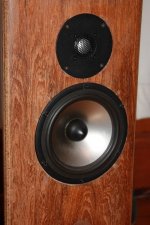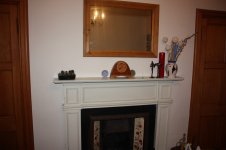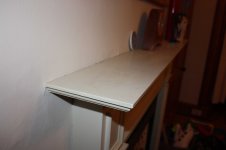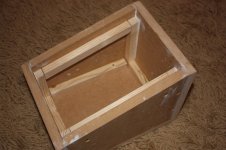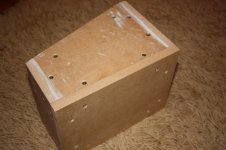Hi,
I thought I would share with you a new loudspeaker design I am building, based on the Jordan JX92S. The design evolved from a desire to build a speaker with a high Wife Acceptance Factor .
I built my first pair of diy loudpeakers around 20 years ago as a school woodwork project, based around a Maplin fibre-glass drive unit and an Audax polycarbonate tweeter. Over the years, I upgraded the drive units to Focal, then Morel, then eventually replaced both driver units with the Seas L18, inspired by Zaph's design Zaph|Audio
I was never completely happy with the sound, which was harsh, particularly with modern over-compressed music, possibly due to inadequately attenuated breakup nodes of the L18 driver and 27TBFCG tweeter (no disrepect to the Zaph design which I cannot claim to have followed too closely)
Anyway, when my wife offered to trade the complete removal of all children's toys from the lounge against the removal of the old boxes, a deal was struck...
The biggest constraints of the new design are size and placement. The boxes must fit on or above an existing fireplace, which is pretty shallow (around 19cm). The listening position is relatively far away from the speakers (relative to the distance between the speakers) which means that for stable stereo imaging I expect to have to toe-in the speakers more than usual. The speakers will also be quite a bit higher than the listening position. All in all, a tricky set of constraints.
I thought I would share with you a new loudspeaker design I am building, based on the Jordan JX92S. The design evolved from a desire to build a speaker with a high Wife Acceptance Factor .
I built my first pair of diy loudpeakers around 20 years ago as a school woodwork project, based around a Maplin fibre-glass drive unit and an Audax polycarbonate tweeter. Over the years, I upgraded the drive units to Focal, then Morel, then eventually replaced both driver units with the Seas L18, inspired by Zaph's design Zaph|Audio
I was never completely happy with the sound, which was harsh, particularly with modern over-compressed music, possibly due to inadequately attenuated breakup nodes of the L18 driver and 27TBFCG tweeter (no disrepect to the Zaph design which I cannot claim to have followed too closely)
Anyway, when my wife offered to trade the complete removal of all children's toys from the lounge against the removal of the old boxes, a deal was struck...
The biggest constraints of the new design are size and placement. The boxes must fit on or above an existing fireplace, which is pretty shallow (around 19cm). The listening position is relatively far away from the speakers (relative to the distance between the speakers) which means that for stable stereo imaging I expect to have to toe-in the speakers more than usual. The speakers will also be quite a bit higher than the listening position. All in all, a tricky set of constraints.
Drive units
Based on the constraints and the desire to keep the boxes as small as possible the internal volume is likely to be between 3 and 5 litres.
After a long scout around I've opted for the Jordan JX92S.
Why? Several reasons:
- I've always been intrigued by the possibility of using a single driver, eliminating the crossover. Ted Jordan waxes lyrical about the advantages of this E.J.Jordan Designs, loudspeaker consultants, designers and manufacturers.
- This driver is designed to be toed in - it has a rising high frequency response complemented by a falling off axis response to give a roughly constant power response. Using the driver slighly off axis should yield a flat response at the listening position. This meets with the requirements of toeing in the design to get a stable stereo image.
- The driver has a better high frequency response, a lower fs and better power handling than most of the fostex full-range drivers I looked at
- There are oodles of diy and commercial designs using this driver. In places it is raved about and can be seen in pretty expensive systems.
- The driver has good distortion (measured here Zaph|Audio)
- It has a relatively flat response. I should be able to get down to 100Hz with a sealed box design. With such a small enclosure there is little advantage is going to reflex (according to the frequency response modelled from the Thiele-Small parameters) and colouration of lower mid may be an issue with a reflex design.
- Although it has an metal cone, it is designed to flex, thus reducing break-up nodes. This satisfies my concern about having to design matched notch filters and living with the associated phase issues
- Jordan has some very interesting example designs on the web site. He suggests mounting the loudspeakers close to the back wall (citing reduced time difference betwwen the primary and reflected signals). As an engineer, I'm surprised that this is an advantage (it just means that the resulting comb filtering will probably affect the midband), but my enthusiasm as a diyer sometimes overrides reason.
- I like the simplicity of the example designs e.g. his 18cmx18cmx18cm monitor. Again, this seems like a crazy design (standing waves emphasised by the cube, diffraction problems a-plenty) but again I see no reason as to why Ted Jordan would promote a bad design if he is trying to sell his loudspeakers
- I'm hoping this will put an end to the constant tinkering I did with my old system (there are just too many degrees of freedom with an 8-element crossover. With this design I only have two components (baffle-step compensator) to deal with. Not a real reason, but there you go.
more to follow
Based on the constraints and the desire to keep the boxes as small as possible the internal volume is likely to be between 3 and 5 litres.
After a long scout around I've opted for the Jordan JX92S.
Why? Several reasons:
- I've always been intrigued by the possibility of using a single driver, eliminating the crossover. Ted Jordan waxes lyrical about the advantages of this E.J.Jordan Designs, loudspeaker consultants, designers and manufacturers.
- This driver is designed to be toed in - it has a rising high frequency response complemented by a falling off axis response to give a roughly constant power response. Using the driver slighly off axis should yield a flat response at the listening position. This meets with the requirements of toeing in the design to get a stable stereo image.
- The driver has a better high frequency response, a lower fs and better power handling than most of the fostex full-range drivers I looked at
- There are oodles of diy and commercial designs using this driver. In places it is raved about and can be seen in pretty expensive systems.
- The driver has good distortion (measured here Zaph|Audio)
- It has a relatively flat response. I should be able to get down to 100Hz with a sealed box design. With such a small enclosure there is little advantage is going to reflex (according to the frequency response modelled from the Thiele-Small parameters) and colouration of lower mid may be an issue with a reflex design.
- Although it has an metal cone, it is designed to flex, thus reducing break-up nodes. This satisfies my concern about having to design matched notch filters and living with the associated phase issues
- Jordan has some very interesting example designs on the web site. He suggests mounting the loudspeakers close to the back wall (citing reduced time difference betwwen the primary and reflected signals). As an engineer, I'm surprised that this is an advantage (it just means that the resulting comb filtering will probably affect the midband), but my enthusiasm as a diyer sometimes overrides reason.
- I like the simplicity of the example designs e.g. his 18cmx18cmx18cm monitor. Again, this seems like a crazy design (standing waves emphasised by the cube, diffraction problems a-plenty) but again I see no reason as to why Ted Jordan would promote a bad design if he is trying to sell his loudspeakers
- I'm hoping this will put an end to the constant tinkering I did with my old system (there are just too many degrees of freedom with an 8-element crossover. With this design I only have two components (baffle-step compensator) to deal with. Not a real reason, but there you go.
more to follow
Box design
On to the box design. The first choice to make is that of cabinet material. My initial thoughts were to use mdf for the back and sides, with a real oak front-baffle. I like the idea of being able to round-over the edges to spread the diffraction frequencies, which would require more tricky veneering if MDF was used. Eventially I was put off over concerns for diffferent rates of expansion and contraction between the MDF and wood (with humidity and temperature( causing splitting of the wood.
So, bring old MDF it is! Fortunately B&Q do a pretty good wood cutting service which makes the cabinet design that much easier.
After umming and arring over the MDF thickness, I've chosen 18mm. This is a very small cabinet, so hopefully the panel vibrations should be minimal.
For construction, I'm using glue-blocks on all the internal joints, with screws screwed through the blocks to ensure good stability and pressure during glueing. This has the advantage of not needing clamps and also offering more stability at the edges of the cabinet. Also, a few experiments with screwing directly into the MDF had poor success, with some of the MDF panels splitting if I screwed in too hard.
Pictures to follow, once I can get my laptop to read the memory card...
On to the box design. The first choice to make is that of cabinet material. My initial thoughts were to use mdf for the back and sides, with a real oak front-baffle. I like the idea of being able to round-over the edges to spread the diffraction frequencies, which would require more tricky veneering if MDF was used. Eventially I was put off over concerns for diffferent rates of expansion and contraction between the MDF and wood (with humidity and temperature( causing splitting of the wood.
So, bring old MDF it is! Fortunately B&Q do a pretty good wood cutting service which makes the cabinet design that much easier.
After umming and arring over the MDF thickness, I've chosen 18mm. This is a very small cabinet, so hopefully the panel vibrations should be minimal.
For construction, I'm using glue-blocks on all the internal joints, with screws screwed through the blocks to ensure good stability and pressure during glueing. This has the advantage of not needing clamps and also offering more stability at the edges of the cabinet. Also, a few experiments with screwing directly into the MDF had poor success, with some of the MDF panels splitting if I screwed in too hard.
Pictures to follow, once I can get my laptop to read the memory card...
Look forward to seeing the results.
If you have not yet started building, try a #8x40mm chipboard screw with a 3mm pilot hole (4mm clearance hole in the through panel). I never have problems with MDF splitting this way.
If you are placing against a wall you can more than likely forget about baffle step.
If you have not yet started building, try a #8x40mm chipboard screw with a 3mm pilot hole (4mm clearance hole in the through panel). I never have problems with MDF splitting this way.
If you are placing against a wall you can more than likely forget about baffle step.
AntM,
If you wish to cut to the chase, I started several threads on DIYAudio that cover my various JX92S designs over the past 8 years. These include a full range mini-monitor in a 7 liters enclosure, the mini-monitor with the addition of a ribbon tweeter, and a MLTL with the ribbon tweeter. You can search for threads and posts by me or start at these points:
http://www.diyaudio.com/forums/full-range/74508-jim-griffins-jx92s-designs.html
http://www.patcave.com/diy2002/s11b6945.jpg
http://www.diyaudio.com/forums/full-range/81634-jordan-ribbon-mltl.html
JX92SG2siDesignPak - eSnips, share anything
Many multiple page threads and such to address whatever you need to know.
Jim Griffin
If you wish to cut to the chase, I started several threads on DIYAudio that cover my various JX92S designs over the past 8 years. These include a full range mini-monitor in a 7 liters enclosure, the mini-monitor with the addition of a ribbon tweeter, and a MLTL with the ribbon tweeter. You can search for threads and posts by me or start at these points:
http://www.diyaudio.com/forums/full-range/74508-jim-griffins-jx92s-designs.html
http://www.patcave.com/diy2002/s11b6945.jpg
http://www.diyaudio.com/forums/full-range/81634-jordan-ribbon-mltl.html
JX92SG2siDesignPak - eSnips, share anything
Many multiple page threads and such to address whatever you need to know.
Jim Griffin
Solve,
Oh, yes the price is high, around £200+vat for both drivers, but I'm hoping you get what you pay for. If I get a cheap driver, I'll probably regret it in a few months and always wonder what I could have got for another £100. Not a huge amount, when spread over the lifetime of the speaker.
Jim,
Thanks for the links. I had noticed your designs before - I like the look of this one... SingleDriverSpeakers Forum - Re: Ping: Jim Griffin - DIY Atlanta speaker - Jim Griffin, November 27, 2004 at 21:14:31
The cabinets are around half completed but there are still a couple of design options I am considering:
- whether to add a 6mm birch-plywood layer on top of the MDF front-panel. If the recess depth of the driver is 5mm, using the MDF-only approach reduces the depth to only 13mm where the driver is mounted. Adding the layer should improve the stiffness of the baffle, but will it make a difference? The panel is 27cm-by-20cm. The cost? around £20 for an 8ftx4ft sheet, plus a slight complication in the design in having to glue on the sheet after I have screwed on the front panel. This will mean I will have to route the baffle after mounting it on the cabinet, which means I run the risk of damaging the cabinet if something goes wrong.
- whether to provide the option of porting. According to the box simulations, adding a port will offer no LF benefit, and have the disadvantage of consuming valuable internal volume. Any comments of whether there are any "second-order" benefits of porting the box.
Oh, yes the price is high, around £200+vat for both drivers, but I'm hoping you get what you pay for. If I get a cheap driver, I'll probably regret it in a few months and always wonder what I could have got for another £100. Not a huge amount, when spread over the lifetime of the speaker.
Jim,
Thanks for the links. I had noticed your designs before - I like the look of this one... SingleDriverSpeakers Forum - Re: Ping: Jim Griffin - DIY Atlanta speaker - Jim Griffin, November 27, 2004 at 21:14:31
The cabinets are around half completed but there are still a couple of design options I am considering:
- whether to add a 6mm birch-plywood layer on top of the MDF front-panel. If the recess depth of the driver is 5mm, using the MDF-only approach reduces the depth to only 13mm where the driver is mounted. Adding the layer should improve the stiffness of the baffle, but will it make a difference? The panel is 27cm-by-20cm. The cost? around £20 for an 8ftx4ft sheet, plus a slight complication in the design in having to glue on the sheet after I have screwed on the front panel. This will mean I will have to route the baffle after mounting it on the cabinet, which means I run the risk of damaging the cabinet if something goes wrong.
- whether to provide the option of porting. According to the box simulations, adding a port will offer no LF benefit, and have the disadvantage of consuming valuable internal volume. Any comments of whether there are any "second-order" benefits of porting the box.
- whether to add a 6mm birch-plywood layer on top of the MDF front-panel. If the recess depth of the driver is 5mm, using the MDF-only approach reduces the depth to only 13mm where the driver is mounted. Adding the layer should improve the stiffness of the baffle, but will it make a difference?
If you are going to get ply to laminate to the baffle, why not just build the whole thing out of birch ply... you'll end up with a better cabinet. Given the size of the cabinet you propose you could probably get enuff pieces out of your 4x8 to do a triple laminate of 6mm.
An example of a sealed 5.5 litre cabinet is here ... we use 15mm, and with the strategically placed bracing have no issues with cabinet resonance. It does require using good multi-ply thou... MDF is just not stiff enuff or well enuff damped. With the driver brace, the 15mm baffle (even with a rebate) works fine.
With you (laudable) philosophy wrt driver price it seems strange that you'd cheap out and use MDF for the box.
dave
Sometimes MDF is all you can easily get in the UK. IOne supplier locally (part of nationwide builder's chain) has stopped because of concerns about tracking it to sustainable sources.
The sheet of ply I have I'm saving until THE project comes along!
btw, may be a concern if you have too deep a front panel. I would have thought the 13mm perfectly ok. Go for the largest volume you can for the cabinet. 5 - 8 litres is ideal for a sealed box for the JX92S. 5 litres may be too small for porting. Do you plan to use with a sub at all? A small one can be hidden quite well and a sealed cabinet may make a better match.
As the JX92 is highly directional, rounding the corners may be less important. I tried putting felt round mine and it didn't seem to make any difference.
On a side issue, whereas the old Beeb designs used thin wall ply damped to drop resonance below the mid-range, I think Harbeth are now using thin wall MDF. Perhaps MDF is actually better suited to this one particular technique as it is inherently less stiff? Anyone know any more on this?
The sheet of ply I have I'm saving until THE project comes along!
btw, may be a concern if you have too deep a front panel. I would have thought the 13mm perfectly ok. Go for the largest volume you can for the cabinet. 5 - 8 litres is ideal for a sealed box for the JX92S. 5 litres may be too small for porting. Do you plan to use with a sub at all? A small one can be hidden quite well and a sealed cabinet may make a better match.
As the JX92 is highly directional, rounding the corners may be less important. I tried putting felt round mine and it didn't seem to make any difference.
On a side issue, whereas the old Beeb designs used thin wall ply damped to drop resonance below the mid-range, I think Harbeth are now using thin wall MDF. Perhaps MDF is actually better suited to this one particular technique as it is inherently less stiff? Anyone know any more on this?
Last edited:
Hi Colin. I have some experience with building speakers of BB and a combination of mdf+soft fiber board. (it is normally used for notice boards)
My A126 horns are made of BB. They sound great, but I have had some problems with a resonance which I think are related to the material.
30 years ago I built a mini horn for a Philips SQ5061 completely built of soft fiber board and then covered with a layer of mdf. No resonances at all and no midrange came out of the mouth.
I have also built a variovent based Dynaudio two way system with the same technique. Absolutely stone-dead cabinet.
There are others that are using soft fiber board for their horn, like HM.
The soft fiber damp frequencies below 200hz.
Wooden Hard Boards, Medium Density Fiberboard, Moisture Resistant Fiberboard, Fire Retardant Fiberboard, Exterior Medium Density Fiberboard
/Anders
My A126 horns are made of BB. They sound great, but I have had some problems with a resonance which I think are related to the material.
30 years ago I built a mini horn for a Philips SQ5061 completely built of soft fiber board and then covered with a layer of mdf. No resonances at all and no midrange came out of the mouth.
I have also built a variovent based Dynaudio two way system with the same technique. Absolutely stone-dead cabinet.
There are others that are using soft fiber board for their horn, like HM.
The soft fiber damp frequencies below 200hz.
Wooden Hard Boards, Medium Density Fiberboard, Moisture Resistant Fiberboard, Fire Retardant Fiberboard, Exterior Medium Density Fiberboard
/Anders
Hi - I've also used ply and soft fibre. Russ Andrews recommends contiboard and soft fibre as ideal but less easy to work with.
planet10, very nice woodworking on your link! I agree with your comments about using the birch ply laminates ... if only I had thought of that before starting constructing the cabinets!
Colin, thanks for your coments. I think you are right about the porting. I will eventually build a subwoofer - I have an idea-in-the-making of building an ultra low-profile (but large area) sub that I can hide underneath the sofa, or between the sofa and the wall ... more on that another time...
With too deep a panel, are you concerned about the rear energy emerging unimpeded from the driver?
To help with the damping, I will be using Wilmslow's deadsheet panels (the ones with the 2mm bitumen panels, plus 10mm acoustic foam, which should help. I am assuming that I'll only lose cabinet volume due to the 2mm depth, not the full 12mm?
Also on the shopping list is some lambswool for attenuation of standing waves (which should also be reduced by the sloping back-panel) with which I intend to fill the entire volume to get a little bit of free volume.
Interesting comment that rounding the edges may not provide much difference. I'm guessing it depends whether the resulting frequency response ripple is in the midband (where the driver response is less directional) or at higher frequencies. From ignorance, I assume the affected band is a function of the baffle width and height, but the amplitude of the ripple will depend on the symmetry of the driver position relative to the edges and the radius of the roundover. I am about to dowload the well known FRD Baffle Diffraction Simulator to find out, though I wonder whether it loudspeaker directionality is modelled.
Colin, thanks for your coments. I think you are right about the porting. I will eventually build a subwoofer - I have an idea-in-the-making of building an ultra low-profile (but large area) sub that I can hide underneath the sofa, or between the sofa and the wall ... more on that another time...
With too deep a panel, are you concerned about the rear energy emerging unimpeded from the driver?
To help with the damping, I will be using Wilmslow's deadsheet panels (the ones with the 2mm bitumen panels, plus 10mm acoustic foam, which should help. I am assuming that I'll only lose cabinet volume due to the 2mm depth, not the full 12mm?
Also on the shopping list is some lambswool for attenuation of standing waves (which should also be reduced by the sloping back-panel) with which I intend to fill the entire volume to get a little bit of free volume.
Interesting comment that rounding the edges may not provide much difference. I'm guessing it depends whether the resulting frequency response ripple is in the midband (where the driver response is less directional) or at higher frequencies. From ignorance, I assume the affected band is a function of the baffle width and height, but the amplitude of the ripple will depend on the symmetry of the driver position relative to the edges and the radius of the roundover. I am about to dowload the well known FRD Baffle Diffraction Simulator to find out, though I wonder whether it loudspeaker directionality is modelled.
The previous two photos are the half-completed cabinets inside and out. The speakers are designed to be mounted on their sides, like this: 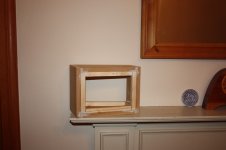
They are pretty small, but still "too big", if you know what I mean!
Finally, here are the dimensions, in cm: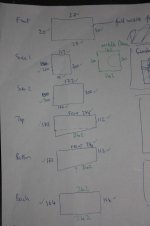
Oh, in case you were wondering, I'm going to actually mount the speakers on the wall slightly above the shelf, to prevent transmission of vibration. I'm designing some special brackets that allow me to mount the speakers as close to the wall as possible.
The weather forecast predicts storms up here in Scotland tomorrow, so no more contruction anticipated until next weekend! (I have a small garden, where all the construction is done).

They are pretty small, but still "too big", if you know what I mean!
Finally, here are the dimensions, in cm:

Oh, in case you were wondering, I'm going to actually mount the speakers on the wall slightly above the shelf, to prevent transmission of vibration. I'm designing some special brackets that allow me to mount the speakers as close to the wall as possible.
The weather forecast predicts storms up here in Scotland tomorrow, so no more contruction anticipated until next weekend! (I have a small garden, where all the construction is done).
Hi
Why so much interior volume "wasted" like that,wouldn't few braces between the largest panels (if any) have been better option ?
Looking forward to see the end results.
Why so much interior volume "wasted" like that,wouldn't few braces between the largest panels (if any) have been better option ?
Looking forward to see the end results.
I'm not sure I would bother with the acoustic foam. The dedsheet is designed to mass load the panels. You can't altogether get rid of vibration only move it in frequency. So the dedsheet is of the shift-it-downwards school and bracing will shift it upwards in frequency. Given the thickness of wood and small enclosed volume by instinct would be to use a couple of braces and fill the interior with wool.
I'm not sure I would bother with the acoustic foam. The dedsheet is designed to mass load the panels. You can't altogether get rid of vibration only move it in frequency. So the dedsheet is of the shift-it-downwards school and bracing will shift it upwards in frequency. Given the thickness of wood and small enclosed volume by instinct would be to use a couple of braces and fill the interior with wool.
I'm of the shift it upwards school (never having been able to make the other work), so agree with Colin....
dave
Reading the Harbeth site, they claim to go for the cracked bell approach, with front and rear panels lightly screwed into the main enclosure. So I guess there is a fair amount of tuning and experience to make the BBC school of damping work. They seem to manage it but everyone else commercially seems to go for a half-way version. Which is probably why Harbeth's work and the others don't.
The contiboard and fibre board is the stiff but light school of enclosure. I have had one pair of speakers built that way and they certainly sounded clean, especially at high volumes. And a dream to move around, given they were 40 litre floor standers.
The contiboard and fibre board is the stiff but light school of enclosure. I have had one pair of speakers built that way and they certainly sounded clean, especially at high volumes. And a dream to move around, given they were 40 litre floor standers.
I've finally found enough time to complete an initial prototype of the speakers. I made a few design changes, including adding an additional 6mm panel to thicken the front baffle. This was necessary due to some over-exuberant routing of the rear chamfer to the driver cutout. I accidentally chamfered the area around the screw holes, meaning that my T-nuts would have nothing to grip. Schoolboy error! I ended up gluing on the additional panel at the back, then filling the voids around the screws with epoxy resin.
I initially listened to the speakers mounted away from the rear wall at listening level. My initial impressions was of lack of bass (I did not include a baffle-step compensation circuit), slightly rough treble, but an incredible soundstage. Listening to Eric Clapton's Unplugged for example, there was a sense of width and height that I had not experienced before, particularly with the audience applause. The speakers themselves seemed to disappear.
There is perhaps a slight colouration in the lower midrange. I can feel the front baffle vibrating slighlty where the baffle meets the edge of the speaker. When I knock the baffle in various places, I can hear the sound change is tone, becoming more "hollow" next to the driver. I was hoping that the speaker frame would stiffen the cabinet here, but this appears not to be the case. I think that some front-rear bracing may be required, as suggested in an earlier post. I have yet to install the damping panels and acoustic foam, so this step may help too. It is also possible that the colouration could be due to the cabinets not being completely sealed, as I have yet to firmly glue on the front and back panels.
With the speakers positioned above the fireplace against the wall (their intended resting place), the soundstage is less impressive, but there is a surprising level of bass, enough to make a baffle-step compensator unnecessary. The treble edginess has reduced, possibly due to driver burn-in. Some beaming is noticeable, but this is no issue whatsoever in the listening position. The best thing about the drivers is that they work "out of the box" without any crossover fiddling needed to get a fantastic sound. The speakers behave the best with recordings of acoustic instruments, or recordings made before digital compression became widespread. With "hot" modern recordings, there is some hardness in the upper midrange and treble, resulting in some listening fatigue.
I'll post some photos once I've had the chance to veneer the cabinets.
I initially listened to the speakers mounted away from the rear wall at listening level. My initial impressions was of lack of bass (I did not include a baffle-step compensation circuit), slightly rough treble, but an incredible soundstage. Listening to Eric Clapton's Unplugged for example, there was a sense of width and height that I had not experienced before, particularly with the audience applause. The speakers themselves seemed to disappear.
There is perhaps a slight colouration in the lower midrange. I can feel the front baffle vibrating slighlty where the baffle meets the edge of the speaker. When I knock the baffle in various places, I can hear the sound change is tone, becoming more "hollow" next to the driver. I was hoping that the speaker frame would stiffen the cabinet here, but this appears not to be the case. I think that some front-rear bracing may be required, as suggested in an earlier post. I have yet to install the damping panels and acoustic foam, so this step may help too. It is also possible that the colouration could be due to the cabinets not being completely sealed, as I have yet to firmly glue on the front and back panels.
With the speakers positioned above the fireplace against the wall (their intended resting place), the soundstage is less impressive, but there is a surprising level of bass, enough to make a baffle-step compensator unnecessary. The treble edginess has reduced, possibly due to driver burn-in. Some beaming is noticeable, but this is no issue whatsoever in the listening position. The best thing about the drivers is that they work "out of the box" without any crossover fiddling needed to get a fantastic sound. The speakers behave the best with recordings of acoustic instruments, or recordings made before digital compression became widespread. With "hot" modern recordings, there is some hardness in the upper midrange and treble, resulting in some listening fatigue.
I'll post some photos once I've had the chance to veneer the cabinets.
I know what you mean about the amazing soundstage.
Try the speakers in your initial position again and I bet the "slightly rough treble" comes back 😉
Try the speakers in your initial position again and I bet the "slightly rough treble" comes back 😉
- Status
- Not open for further replies.
- Home
- Loudspeakers
- Full Range
- New Jordan JX92S mini-monitor design
